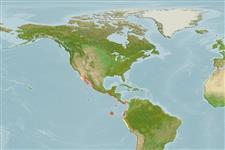Environment: milieu / climate zone / depth range / distribution range
Ecology
Marine; pelagic-neritic. Tropical; 34°N - 17°S, 121°W - 71°W
Eastern Pacific: Southern California, Gulf of California and the western coast of Baja California, Mexico to Peru, including many offshore islands.
Size / Weight / Age
Maturity: Lm ? range ? - ? cm
Max length : 106 cm TL male/unsexed; (Ref. 55763); common length : 20.0 cm TL male/unsexed; (Ref. 9301)
Dorsal spines (total): 0; Dorsal soft rays (total): 17 - 20; Anal spines: 0; Anal soft rays: 16 - 19; Vertebrae: 75 - 76. Rows of spinules in skin easily seen but individual spinules difficult to discern. Color in life orange to red above, with brownish and black blotches. Lighter below. Dorsal and anal fins with orange bases. Caudal filament dusky (Ref. 9826). Branchiostegal rays: 5 (Ref. 36710).
Adults occur at depths greater than 30 m, along continental and insular margins (Ref. 36710), over rocky substrates (Ref. 37955). Feeds on small fishes (Ref. 37955). Marketed fresh, salted or dried and smoked but more frequently processed into fishmeal (Ref. 9301).
Life cycle and mating behavior
Maturity | Reproduction | Spawning | Eggs | Fecundity | Larvae
Fritzsche, R.A. and M. Schneider, 1995. Fistulariidae. Cornetas. p. 1104-1105. In W. Fischer, F. Krupp, W. Schneider, C. Sommer, K.E. Carpenter and V. Niem (eds.) Guia FAO para Identification de Especies para lo Fines de la Pesca. Pacifico Centro-Oriental. 3 Vols. FAO, Rome. (Ref. 9301)
IUCN Red List Status (Ref. 130435: Version 2024-1)
Threat to humans
Harmless
Human uses
Fisheries: subsistence fisheries
Tools
Special reports
Download XML
Internet sources
Estimates based on models
Preferred temperature (Ref.
123201): 20.6 - 28.4, mean 25.6 °C (based on 66 cells).
Phylogenetic diversity index (Ref.
82804): PD
50 = 0.6250 [Uniqueness, from 0.5 = low to 2.0 = high].
Bayesian length-weight: a=0.00112 (0.00059 - 0.00213), b=2.86 (2.69 - 3.03), in cm total length, based on LWR estimates for this species & (Sub)family-body (Ref.
93245).
Trophic level (Ref.
69278): 4.5 ±0.80 se; based on food items.
Resilience (Ref.
120179): High, minimum population doubling time less than 15 months (Preliminary K or Fecundity.).
Prior r = 0.54, 95% CL = 0.36 - 0.81, Based on 2 data-limited stock assessments.
Fishing Vulnerability (Ref.
59153): High vulnerability (64 of 100).
Nutrients (Ref.
124155): Calcium = 102 [58, 252] mg/100g; Iron = 1.61 [0.88, 2.91] mg/100g; Protein = 18.1 [16.9, 19.4] %; Omega3 = 0.197 [0.100, 0.415] g/100g; Selenium = 109 [48, 246] μg/100g; VitaminA = 9.97 [3.26, 29.30] μg/100g; Zinc = 0.838 [0.554, 1.279] mg/100g (wet weight);
